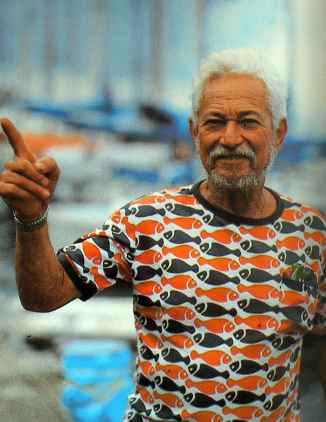Rodo Williams

Ben Finney describes Rodo Williams as "my longtime Tahitian friend ..., a professional fisherman and copra boat skipper whose job was to pilot us safely past the atolls that lay just to the north-northeast of Tahiti [Tuamotus]" ("Playing with Canoes," in Pacific Places, Pacific Histories, ed. by Brij Lal, U. Hawai‘i Press, 2004, p. 295).
Elsewhere Ben writes, "To prepare Mau Piailug for the voyage, David Lewis briefed him on the geography of the islands in this part of the Pacific and the winds and currents that could be expected along the way, all information that an early Polynesian navigator acquainted with this route would have carried in his head. ... During his first few days of the voyage, Mau received further coaching on the pattern of winds and currents from Rodo Williams, a veteran Tahitian seaman on the crew who the year before had sailed a yacht from Tahiti to Hawaii and could therefore provide Mau with a firsthand account of what he could expect to encounter" (Voyage of Rediscovery: A Cultural Odyssey through Polynesia, 1994) p. 66).
In We the Navigators (2nd edition, 1994), David Lewis recalls Rodo's knowledge and skill as Hokule'a approached the Tuamotus on her first voyage to Tahiti in 1976:
Shortly before dusk that evening, the familiar swell from the southeast had been abruptly cut off. We could only have sailed into the shelter of the Tuamotus. Then Rodo Williams, the Tahitian navigator, spotted two itata'e [white terns], a species of tern that, he explained, did not fly farther than 30 miles from land. About 6 pm they flew off to the southeast.
We followed this southeast course, and as night closed in, everyone was watchful. The Tuamotus are, with good reason, known as the "Dangerous Archipelagos." The coral is razor-sharp and can rip through the bottom of a boat before the dim silhouette of an atoll can be seen through the darkness. Our care was rewarded. At about 0300 on 1 June a black line became visible on the port bow. It steadily grew darker and more solid--an atoll. We came about and hove-to to await daylight. The three navigators [Mau Piailug, Rodo and David] discussed the island's identity. We agreed that our latitude of something under 16 degrees S meant that we were south of the northernmost Tuamotuan atolls but still well north of Tahiti. The only atolls that would fit the bill seemed to be Tupai, north of Bora Bora, and Mataiva, the westernmost of the Tuamotus.
It was here that Rodo Williams' local knowledge and expert dead reckoning came into its own. I was inclined to favor Tupai. According to Rodo's dead reckoning, on the contrary, we had regained a good deal of the easting we had lost and should be near the longitude of the Tuamotus. Moreover, the itata'e and the swell shadow both pointed to the proximity of the Tuamotus. He plumped firmly for Mataiva, and daylight confirmed his judgment. Here was a solitary atoll with no tall Bora Bora rising behind it--it was indeed Mataiva.
With our arrival in Mataiva, where we were entertained royally, the navigational portion of the Hokule'a voyage was virtually at an end. (335)
"When Hokule'a sailed south from Hawaii to Tahiti in 1976, three people on board accurately predicted, on the previous day, their landfall in the west of the Tuamoturs, after a voyage of more than 2000 sea miles (Finney 1979b: 340). Two of them, David Lewis and Rodo Williams, were using zenith stars; the third, Mau Piailug, a master navigator from the Carolines, was using a plotting system not yet fully understood by Western scholars." (Geoffrey Irwin, The prehistoric exploration and colonisation of the Pacific, 1994, p. 51).
"Kimo [Lyman] was crew aboard the voyaging canoe Hokule'a on its Tahiti to Hawaii return. His brother, the late David Lyman, had sailed with an old family friend, Rodo Williams, on the Hokule'a’s original Hawaii to Tahiti leg. Rodo was one of the last of the Polynesian native navigators. I met Rodo while cruising the South Pacific with my family aboard Rejoice, 1979 to 1981. We met Rodo through a family friend also cruising at that time, Mary Miles Morrison, who was interviewing Rodo to transcribe Polynesian folklore so it would not be lost with Rodo" ( Chip Donnelly in "Honolulu to Nadi, Fiji on Van Diemen III," Hard on the Wind, Newport Harbor Yacht Club, July 2008).
